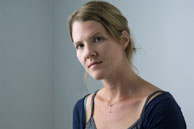MCAD/Jerome Artists 2005-06: Angela Strassheim
Essays by Kristin Makholm, MCAD Gallery Director and Program Director, MCAD/Jerome Foundation Fellowships for Emerging Artists


Angela Strassheim
In his play As You Like It, Shakespeare began Jacques’ monologue by reminding us, “All the world’s a stage.” This is a particularly loaded idea when it comes to photography, a medium that has seesawed between the suspension of belief and disbelief, between truth and deception, ever since its origins in the mid-19th century. As posed or cropped, manipulated or coerced as photographs can be, we generally believe that an apparent snapshot of a commonplace occurrence is just that, and with it comes that elemental spark of Truth. In the hands of Angela Strassheim, the scale tilts back and forth, making our world somehow seem uncanny to our eyes.
We all know and understand the world that Strassheim reveals in her photographs: children playing hide-and-seek; a father grooming his son in the bathroom; a family dinner at McDonald’s; the funeral of a beloved grandmother. A former forensic photographer, Strassheim illuminates each of these scenes with the cold, calculating light of fact, made sharper with the knowledge that this is, in most cases, Strassheim’s own extended family of born-again Christians, in which she has often felt on the fringe. With her critical yet loving eye, she sets up each shot—moves the furniture, adjusts the lighting and props—and then lets her family (or, in some cases, actors) recreate the minutiae of everyday life and her remembrances of times past.
Untitled (Grandmother’s Closet) bears the imprint of Strassheim’s memory. The photograph documents the closet of the artist’s grandmother, who in Untitled (Grandmother) rests peacefully in a coffin wearing the pink dress she chose for her funeral and post-mortem photo shoot. Like any closet belonging to an elderly woman, it sports neatly hanging clothing, rows of sensible shoes and Depends on the upper shelf. But the television set, resting on a short pedestal beneath a row of blouses, catches one off-guard; it was hidden in the closet because watching TV was considered to be a sin in some fundamentalist circles. Strassheim remembers sitting in front of this closet and watching TV with her grandmother on special days, waking up past midnight to the noxious glare of a test pattern.
If memory, artifice and candor are the hallmarks of Strassheim’s photographs, then it is only a side step from the photographic reproduction of this space to a physical recreation of the closet, as Strassheim has done for this exhibition. With the sensory addition of a droning test screen and “grandmother smells,” the installation heightens the capture and fixation of memory, mediated as it is by a granddaughter’s love and acknowledgement of her grandmother’s contradictions. Through all her work, Strassheim creates a stage that preserves the often-paradoxical qualities of our families and our backgrounds. (K.M.)